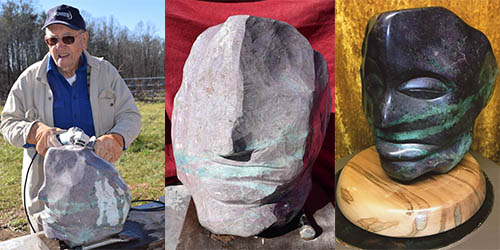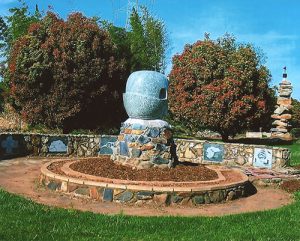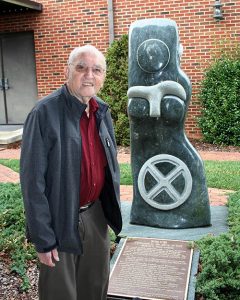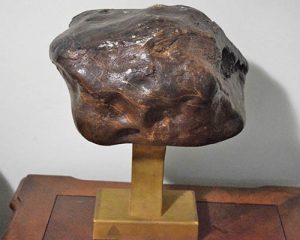
Editor’s Note: This article was originally published in Rock & Gem in 2017, but was not placed on the site. With the passing of Mr. Richard Sipe, Sr. — the gem carver profiled — in the autumn of 2018, we wanted to make certain his work and story was shared here.
Story by Warren L. Hollar
Passion is an important part of maintaining a productive life at any age. How can one reach the age of 90: good genes, good eating habits, good activity, and good social engagement?
Richard V. Sipe, at age 90, enjoys many of those things, but says his passion for carving corundum is a major force in giving a sense of meaning and purpose to his life.
Richard’s passion is not just gemstone carving. He has chosen to work with one of the most difficult gem media—corundum—and he only wants to sculpt the largest ones. His life’s work has been punctuated by three large pieces of corundum.
Purposeful Living

The properties of corundum provide a clearer understanding of the difficulty of undertaking his passion: It is an exceptionally hard and tough material. On the 10-point Mohs Scale of Hardness, is an index mineral for No. 9, one place below diamond. It is not only is it difficult to shape these stones, but extremely time-consuming and expensive.
Richard was born in 1927. He served in World War II, then began his career as a stonemason in 1950, after studying under an Italian stonemason in Pittsburgh, Pennsylvania. While working on construction sites in North Carolina, he found many interesting rock specimens, which motivated him to become a self-taught rockhound. He soon began his own construction company, which allowed him additional access to gem and mineral specimens.
During his early days of sculpting, his works included a 7-foot-tall sculpture carved out of a composite of nephrite jade that was displayed at his church. He named the sculpture “Wisdom”.
After that came “200 Years on the Road”, a 9-foot-tall nephrite jade sculpture representative of a circular road leading from the past to the future that stands in front of a 30-inch-high by 75-foot-long stone wall etched with nine scenes that reflect how U.S. historical events, such as slavery and the Civil War, impacted North Carolina history. Other scenes, such as the Tree of Life, were inspired by the Book of Revelation, in the Bible.
This sculpture took Richard 12 years to complete. It is displayed at his home in Conover, North Carolina, and was featured in the Jerry Bledsoe book North Carolina Curiosities. “200 Years on the Road” was, Richard says, the first sculpture that made him feel like an artist in stone.
Language of Stones
In an interview, Richard spoke to me about the life force he felt in each unique stone and how the stone could speak to him. Interestingly, his approach to sculpting used the stone itself as inspiration. As did Renaissance sculptors, he believed his work freed the form trapped inside the stone. Richard often grew a beard before he began work on a sculpture, and let the stone dictate the outcome as it became a work of art. His time frame for working with a single piece was not measured in days or weeks, but in years. Richard is also known for the special sculptures he has made for the Waldensians in Valdese, North Carolina, and as volunteer projects for local organizations such as the Fireman’s Museum and Sipe’s Orchard Home.
The discovery of 20 large corundum specimens at the construction site of a bowling alley in Newton, North Carolina, about 50 years ago whetted his love for sapphires and rubies.
Many smaller corundum crystals in gray, blue and yellow were also dug out of the construction site. His first exceptional sapphire, weighing 38 pounds (80,669 carats), came from the bowling alley construction. Richard sculpted it, and named the work “The Link”.
For many months, he studied the shape, veining stratification, and structural weaknesses of the sapphire. He knew that grinding with power tools and the use of diamond grit were not only expensive, but would change the shape of the piece forever. Almost two years passed before he made his first attempt at bringing the stone to life. The expense of the diamond wheels was a financial deterrent throughout the process. After the initial grinding to get out the pits and bad places, polishing the stone required 13 different steps to complete.
Carving Leads to Guinness Connection
As his work progressed, Richard needed to go beyond the

8500 diamond disk that was available at the time. Fortunately, he found a 200,000 grit film from a supplier in Georgia that allowed him to proceed with polishing the stone. After he completed polishing and sculpting the sapphire to a weight of 22 pounds, and he had it authenticated by chemical analysis and submitted an application to have it included in the Guinness Book of World Records.
The application was approved, and “The Link” was included in the 1999 edition as the largest carved sapphire. This piece is currently on display in the Catawba County Historical Museum, in Newton. The stone remained in Guinness until it was surpasses by the 27-pound, football-size “Millennium sapphire” from Madagascar, a gem carved with the likenesses of historical figures by Italian artist Alessio Boschi. The carving, considered one of the wonders of the world, is available for sale if the right buyer can come up with $180 million.
The quest for large sapphires led Richard to his second stone of note. At a gem and mineral show in Spruce Pine, North Carolina, he heard a rumor about a giant sapphire, as large as a football, located somewhere in the southeastern United States. After much searching, he found the rumored corundum in Spruce Pine, lying on a hearth next to an old woodstove.
He traded a hand-made stone table for the 63-pound sapphire, which was of Brazilian origin, and began his journey to bring out the spirit of the stone.
Evolution in Skill and Opportunity
Richard had the stone authenticated by sending samples of it to the Gemological Institute of America (GIA). Lab tests confirmed that it was a semitranslucent to opaque, variegated piece of natural corundum. He then had the rough stone photographed, made an aluminum cast of it, and had an artist paint the cast to reflect the original specimen. He then began his quest to bring the artistic features out of the “Sipe sapphire”. It took him nearly two years to get to a point at which he was satisfied. In his words, “You’re never finished with a sapphire. You are never to the point where you can’t get a better polish.”
Richard took great care when shaping the stone not to create any cracks in it. When his modifications were complete, the sculpted stone weighed 38 pounds, which exceeded the weight of the world-renowned “Millennium sapphire”. The Guinness Book of World Records confirmed the “Sipe sapphire” as the largest polished sapphire in existence in 2005.
Richard believes the giant sapphire could star if polished correctly, and that it would serve as a worthy addition to the Catawba County Historical Museum.
What could be the next quest for a man approaching 90 years of age? Always looking for the next challenge, in 2013, Richard purchased a 130-pound corundum (over 250,000 carats) from a dealer in Philadelphia. The corundum originated in Southwest India. He began the journey to creating a unique piece of art by sending a sample of the corundum to the GIA for identification. The test results showed the specimen to be a natural ruby with fuchsite. As with his other projects, he studied the ruby for months to let the rock speak to his creative talents. He also enlisted the aid of juried stone-carving artisan Earl Gray, of Glenwood, West Virginia, whose work is displayed at the prestigious arts and crafts shop Tamarack: The Best of West Virginia, in Beckley, for his most ambitious project.
Searching Beyond the Surface

As Richard began to bring out the essence of the stone, he began to note the appearance of two faces. At first, he thought about naming the piece “Ruby Two Face”, but the name just did not seem to fit. As he proceeded with sculpting and polishing the stone, he saw a face that looked like a fossil head to him. Another face appeared, which seemed to have a big nose. He enlisted his 8-year-old great-grandson to provide an opinion.
Since his great-grandpa said the stone talked to him, the boy listened carefully, but heard no talking. He told Richard that he didn’t hear anything, but he agreed that it looked somewhat like an Indian chief. Working carefully with a diamond-padded angle grinder, Richard began to see the flow of long hair. Now he knew the piece had to be called “The Chief”. From that point on, the flow of his sculpting led him to define two faces for “The Chief”. The fuchsite gave the appearance of “war paint” across the cheeks of the sculpture.
He put the carving aside for several months and then decided his sculpture was near completion. In his words, “corundum can always shine brighter”. After almost four years of work, he was ready to display his third large corundum sculpture in 2016.
After his 90th birthday in March 2017, Richard made plans for the ongoing display of his three large corundum projects. His plans include donating the works to the Catawba County Historical Museum in his hometown. He worked with the museum to develop a Web page, and to display the pieces at several selected sites. The three pieces were displayed at the March 2017 Catawba Valley Gem and Mineral Show in Hickory, North Carolina. Both vendors and attendees were fascinated and charmed by the size and luster of his handiwork. After the show, “The Chief” was transported to New York City to begin the application process for the Guinness record as the largest polished ruby.
Appreciating All Life Has to Offer
Asked if he was ready to slow down, Richard said, “It’s full speed ahead. I’m ready for the next project.” Asked what that might be, he jokingly said that he “might find a bigger corundum in the mines in Southwest India”, where he’d heard there were specimens weighing 200 pounds. Interestingly, he has been in contact with a Philadelphia dealer who negotiates with the mines in India. He continued teasing, “I might even need someone to do a side trip to the diamond mines in South Africa to get enough diamond dust for my grinders.”
Richard says, “I’m truly just an old country boy who loves rocks. I don’t want to accumulate wealth.” The value estimates for his three corundum sculptures, however, approach the seven-figure range. He thoughtfully stated, “I just wish to help others appreciate what God gave us to treasure from the earth.” One can only hope to develop a passion for life like this 90-year-old man, who believes his stones speak to him!
About the Author: Dr. Warren Hollar is a member of the Catawba Valley Gem & Mineral Club, a retired school administrator, and a retired clinician of the University of North Carolina, Charlotte.













